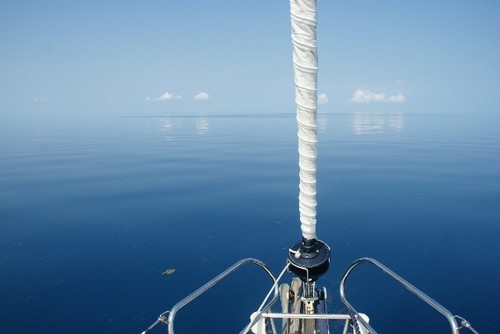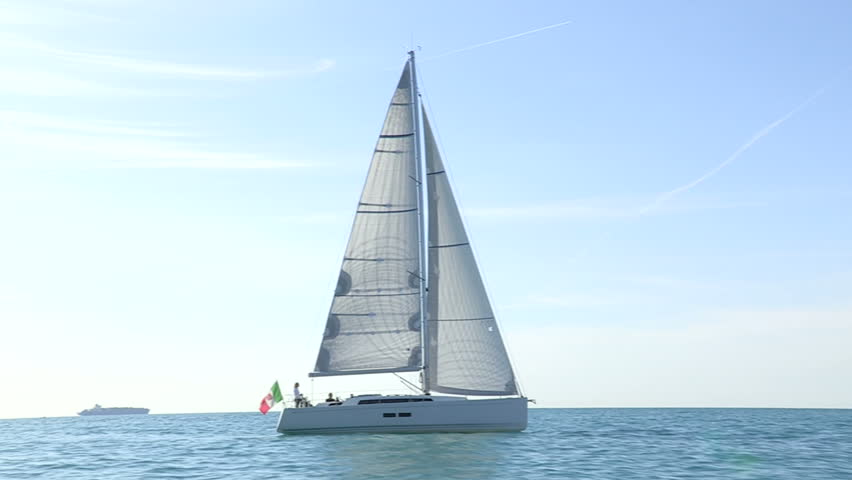How to Sail in Little or Without Wind
The hot windless summer doldrums can take much of the fun out of sailing. But, they can also be a challenge for patient and skilled sailors. If there is the slightest hint of a breeze (what sailors call “light air”), there is a hope for getting your small centerboard-equipped sailboat to glide across the water. This article provides ten tips that I found effective when I sailed a 19-foot Flying Scot sailboat.
These Tips Should Work For Most Sailing Dinghies In Light Air Conditions:
Lighten The Weight Of The Boat
With little or no wind, unneeded items like coolers and extra gear let the boat sit lower in the water, let the rudder sit lower in the water, and put more drag on the boat. In addition, it takes more wind to get a heavier boat moving. In light air, you want a light boat.
Move Towards The Center Of The Boat
If you move yourself, your crew, and any weight aboard towards the center of the boat, the stern of the boat should be lifted a bit. This will reduce the amount of rudder immersed in the water and reduce drag. As a skipper, you can use a tiller extension to steer from the center of your boat.
Pull Up the Centerboard
The centerboard on your boat is vital for pointing and working your way upwind. It also helps prevent your boat from capsizing. However, in a situation with little wind, you can partially pull up the centerboard. This will greatly reduce the drag of your boat in the water. You’ll have to experiment to see how much you can pull up the centerboard without affecting your boat’s pointing ability. You may be able to pull up your centerboard half-way, three-quarters of the way, or if the “wind” is at your back, all the way. However, if a real breeze does kick up, you’ll have to remember to lower your centerboard.
Heel The Boat
When your boat is becalmed, the sails will just sit limp with no shape or form. Sails work like wings, and lift translates into propulsion. If you have everyone sit on one side of the boat, the boat will heel over, and the sail should sag towards the crew. You can even pull the boom and sail towards the crew to ensure that the sail has a shape. The object of this exercise is to have the sail bag out to one side so that it can act as an airfoil and make the most of the slightest breeze. In light air, you have to give your sails a sense of direction.
Seek The Ripples
Ripples on the surface of calm water indicate a slight breeze. If you can get your boat into an area of ripples, you can use the breeze to get moving. If you follow the ripples like a vein of gold, you may get a sizable advantage over other becalmed boats.
Minimize Movements Aboard
When your boat is becalmed, you and your crew also have to be calm. Unnecessary movement by the crew can rob your boat of momentum, upset the shape of your sails, and cause additional drag. In light air conditions, sudden movements of the centerboard or rudder can really put the brakes on a slow-moving sailboat.
Use The Current
If currents are going in the right direction, you can use them to help move your boat. But, note that you shouldn’t go down a river from your marina during a time of little or no wind. The light breezes may not be sufficient to propel you back up the river against the current. You’ll be forced to paddle or use an outboard to move your sailboat back to the marina. In light air, being down the creek without a paddle is worse than being up the creek without a paddle.
Make Slow And Steady Tiller Movements
The rudder makes the boat turn by redirecting the water that flows across the rudder surface. In light winds, if you make sharp rudder movements, the drag may increase enough to slow the boat. In light winds, you’ll want to use move the rudder minimally in order to change the boat’s direction without bringing it to a stop. You’ll generally want to conserve your boat’s momentum and keep it gliding across the water as long as possible.
Tack Or Jibe With Authority
If you are rounding a mark and need to tack or jibe, you may have to move the tiller with enough authority to ensure that the boat doesn’t stall and sit becalmed or luffing. A good hard pull on the tiller may kick the boat around through the “wind” and onto a new course. The crew may have to manually move the jib and mainsail across and move quickly to heel the boat and shape the sails for your new course.
Use The Rudder To Paddle
If you aren’t in a racing situation, you can work your tiller back and forth to propel your boat forward using the rudder in the same manner that a fish uses his tail to swim. In a lightweight boat, this can help you get into an area of ripples where you can catch a breeze. Of course, actual paddles will work even better to get the boat moving to an area of ripples.

Good luck and don’t sweat it. Even on the hottest of days, a slight breeze usually kicks up as the sun begins to set.
